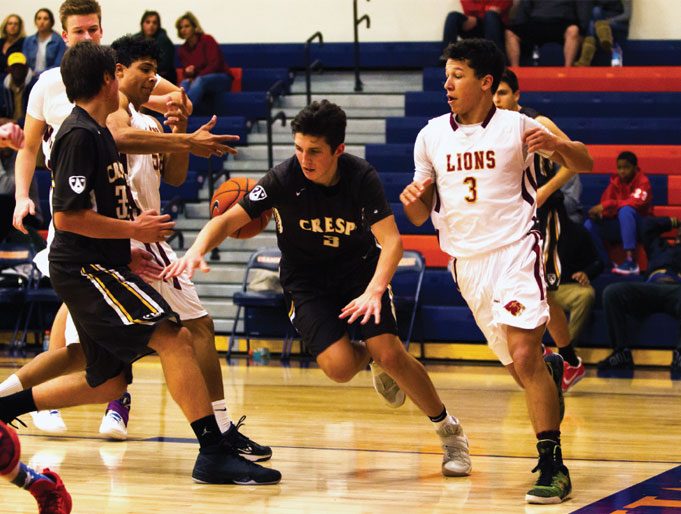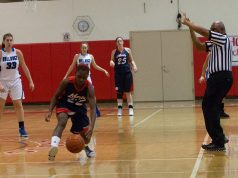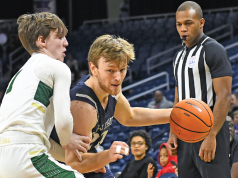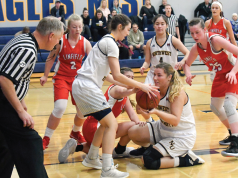If there is one rule many officials are loath to enforce, it seems to be the three-second violation. For them, ruling a three-second violation carries the same stigma as riding in the Tour de France with training wheels. Their mantra is that if you understand the game, you do not understand why this rule is needed — but is that a fair assessment? Let’s dig a little deeper.
With the ball in the frontcourt and in his or her team’s control, it is a violation in NFHS rules if an offensive player spends three seconds in contact with the free-throw lane. NCAA M/W rules similarly outline a violation but with language that states “more than three consecutive seconds.”
The basketball rules are designed to penalize the team causing the problem; the problem is always interference with either the free flow of the game or with the athleticism of the players. A subset of the rules, then, is the time-limit violations, designed to prevent the offending team from turning the game into an actionless contest. By this standard, the 10-second rule forces a team to advance the ball and play it in the limited area of the frontcourt; without it, teams could play keep-away in the fullcourt area and reduce games to 4-2 snooze fests; chess would sell more tickets. The five-second rule, meanwhile, forces a team to distribute the ball in the frontcourt rather than allowing it to be interminably controlled by one or two players, with conceivably no effort to score. The three-second rule forces a team to tactically advance the ball to score rather than just putting it in the hands of perhaps the tallest player; he or she could then spend the evening outjumping opponents and potting bunnies by the dozen. Without the three-second rule, Wilt Chamberlain’s famous 100-point game might have been an off night for him and others. The rule forces the relative mutants on the floor to move to score rather than merely taking up ice fishing in the free-throw lane.
The free-throw lane: Therein lies the problem. This 19’ x 12’ expanse is completely the wrong size and shape to adequately address the spirit of the rule and fairly penalize the offense for spending too long in it. Down near the basket, many post players are perfectly happy to set themselves with two feet near the block and play one-on-one from there; it is almost as good as not having the rule at all, for them. Conversely, many defenses would love to have the enemy bigs prosecute the contest up by the free-throw line, trying their hand at unmolested 14-footers all night long. The sweet spot, then, is roughly the bottom half of the free-throw lane. If the officials allow too much loitering there, not only are the big players rewarded but the defense is forced to adapt progressively rougher tactics to counteract its superiority. In this context, we “get” that some officials choose to call “what really matters,” but to extrapolate that to calling “nothing at all” detracts from the game.
So, when is the “right time” to rule a three-second violation? With apologies to the various rules committees, never and always are both wrong answers if the objective is keeping the game appealing to everyone present.
Here are a few guidelines to consider going by:
Is the offensive player obviously standing in the free-throw lane, with no intention of leaving?
One philosophy considers it preventive officiating to shout a player’s number or yell “move” or “clear” to a player who remains stationary in the free-throw lane and is approaching a three second violation. That philosophy is outdated in today’s game where the directives are to enforce the rules as written.
Is the noticed player trying to obey the rule or trying to flaunt it?
This is where we get into the minutia of whether the player actually spends three seconds or four seconds in the free-throw lane and whether it matters that the player tried to step out of the free-throw lane but left one foot touching the free-throw lane line. Some have the philosophy that it is wrong to split hairs that finely when the real question is intent. If the player is disadvantaging himself or herself by trying to obey the rule, it seems capricious to ding them on a technicality because their shoelace was too long.
A tactic that has crept into the game recently is for the defense to lie in wait for the post player to enter the free-throw lane and then group-screen that player to prevent him or her from leaving the free-throw lane promptly. The argument is that this time-count violation is just as egregious as a five or 10-second violation. In the latter two cases, the rule penalizes the team that is trying to stall or rewards the other team for good defense.
In the three-second case, there is no rules language or an interpretation that deals with this situation. Three seconds is three seconds. However, it is not unreasonable to give the benefit of the doubt to the player leaving the three second area in this scenario. Consider checking with those in your area for local practice and any guidance on the interpretations within the games you work. Note that all rulebooks instruct the officials to allow a player who, having been in the restricted area (free-throw lane) for less than three seconds, to dribble in or make a move to try for goal, whereas the five- and 10-second violations make no such provision; they require a hard count. The insinuation is that the player’s effect on the play has to be considered for a three-second violation to be warranted.
The three-second violation is very much a reflection of the officials’ understanding of the competition in front of them. Knowing when to rule the violation and when to lay off in the spirit of the rule will be one of the more technical things separating a strong official from the rest.
What's Your Call? Leave a Comment:
Note: This article is archival in nature. Rules, interpretations, mechanics, philosophies and other information may or may not be correct for the current year.
This article is the copyright of ©Referee Enterprises, Inc., and may not be republished in whole or in part online, in print or in any capacity without expressed written permission from Referee. The article is made available for educational use by individuals.


















